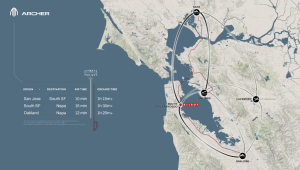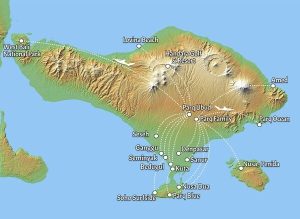
The latest update to the 500 page plus Global AAM/UAM Market Map database now includes details on 249 individual advanced/urban air mobility programmes in 60 countries throughout the world. In the USA there are now 72 city/state/airport AAM programmes alone. In this first of a two-part analysis of the developing AAM global market we look at how competitive tourism and coastal/island networks are being developed around the world. For sample data and more information on the market map please contact the editor philip@unmannedairspace.info
There are several parallel races going on around the world to decide who will win the first races in the great global advanced and urban air mobility market challenge. The first race is certification and entry into commercial service, which has been won comfortably by China’s EHang. But, in terms of overall market success, this is arguably not the most important one; certification “merely” gets you to the starting line. It is the second race which will really matter – the setting up ecosystems and networks which will allow eVTOL manufacturers and operators to scale up at speed from the first tentative commercial flights to full-blown revenue generating services of increasing frequencies and destinations. These networks require substantial planning and cooperation by all stakeholders – eVTOL operators, maintenance companies, local authorities, vertiport operators, traffic management organisations – and the race has been on for some time now to ensure that, once certified, these new vehicles can fit seamlessly into a fully certified operating network. So who is winning the network race?
There are really four races here, four very different types of UAM/AAM networks under development. The first, and simplest, is the tourist network – based on adhoc, sightseeing or charter flights, using current aviation facilities such as hotel-based heliports. Then comes the coastal/bay area/island networks, with some sightseeing trips but mainly scheduled operations which offer passengers a quick flight across the bay rather than a long drive along the coast or a lengthy boat ride, again using mainly current aviation infrastructure. Then there are regional networks, flying from cities to cities or regions to regions often more than 100km apart, also using existing infrastructure where possible. Then finally, we have the complex urban networks, with short distances and new vertiports developed in city centres and peripheries, by far the costliest and the most time-consuming of the four ecosystems under development.
The dividing lines between these different eco-systems are sometimes blurred. For example, Incheon has developed an AAM plan which includes all these four networks plus a dedicated cargo eVTOL operation. And their rate of scalability will depend on whether they are planned and supported by central government, with many stakeholders, or by industry, with far fewer. The ideal combination for rapid development seems to be: eVTOL manufacturer/operator, vertiport developer and local/regional authority.
Network One; ad hoc tourism
The tourist network is the entry point to the entire AAM eco-system and China’s cities and AAM industries are well ahead in this race. Ad hoc tourist flights are planned for several cities in China this year. Guangzhou and Hefei have already experimented with EH216 sightseeing flights, including the Luogang Central Park in Hefei, the world’s largest urban central park, covering a total area of 12.7 square kilometers.
Hard on the heels of China is, inevitably, the Middle East. Eve Air Mobility and Falcon Aviation Services have signed a letter of intent for up to 35 eVTOL aircraft, with deliveries expected to start in 2026. The partnership will introduce the first eVTOL tourist flights from the Atlantis resort hotel at The Palm in Dubai.
In May 2024 news website Capital GR reported that Libra Group, through its subsidiary company Aria Hotels, planned to build and operate four vertiports in Greece, which will support eVTOL aircraft. “The plan is to place them in strategic points, such as Athens, southern mainland Greece and the Cyclades, in order to strengthen regional connectivity and promote ecotourism. It is the first construction of its kind and is part of an investment of EUR 50 million, to promote eVTOLs and strengthen the sustainable economy in Greece,” said the news source. Aria Hotels has leased 10 BETA ALIA eVTOL aircraft through an agreement with LCI, a Libra Group subsidiary and leading aircraft lessor.
All-electric aircraft flights are planned from Sydney to Canberra three times a day and over the Great Barrier Reef by 2026, following the deal between Sydney Seaplanes, Nautilus and Eve Air Mobility to fly 60 eVTOLs in Australian airspace by 2026. Tourism flight operator Nautilus – which has bases in Cairns, Port Douglas, Townsville, Horn Island and Darwin, plans to fly 10 Eve eVTOLs on scenic flights over the Great Barrier Reef and other tourist attractions. Sydney Seaplanes will also take delivery of 50 Eve eVTOLs by 2026 to fly new routes from the company’s Rose Bay terminal (subject to community consultation).
Other, more distant tourist networks under development include Bali and Australia, where the government’s “AAM: Industry vision and roadmap” envisages theme park air tourism, charters from Melbourne city to regional areas (the Yarra Valley wineries, for example) and Sydney Harbour air tours as a first wave of AAM operations in 2027.
| Island hopping in Korea and Indonesia with eVTOLs
Two interesting island-hopping tourist eVTOL networks in the Far East are being planned. Jeju Island in Korea plans to launch air taxi flights for tourists by 2025. According to the Korea Herald, Jeju Island, Kencoa Aerospace and the Jeju Free International City Development Centre (JDC), plan three routes across the island, connecting Jeju International Airport to the island’s southern Mosupo region, then links Moseulpo to Gapado and Marado and a third route moves along the east coast near Seongsan Ilchulbong, a popular tourist spot also known as Sunrise Peak. Chanyoung Chung, Head of UAM Strategic Business at Kencoa Aerospace, was reported as saying: “This would allow tourists to hop on an eVTOL aircraft at Jeju airport; then directly land at tourist spots to be transferred to waiting air taxis nearby. The timeframe will be during 2025.”
Meanwhile, in Bali, an AAM network is under development following the March 2024 agreement between Sirius Aviation and PARQ Development, to provide ten hydrogen-powered vertical takeoff and landing (VTOL) jets along with tailored support services. The agreement is estimated to be worth USD50 million. Under the deal, PARQ Development will receive five Sirius Millennium Jets and five Sirius Business Jets for operations in Bali and the nearby islands. Additionally, Sirius Aviation AG will establish five vertiports and five hydrogen generators, facilitating VTOL operations, enhancing accessibility, stimulating eco-friendly tourism, and economic growth in Indonesia. |
Network two: the coastal/bay area/island networks
Of these four networks, the coastal/bay area/island networks are by far the most interesting as they offer the first substantial revenue-earning opportunities with real opportunities for eVTOL developers to pay back their initial investors. Although there are several of these networks in development globally, the key competing industry-led networks are centred on densely populated areas such as the Mediterranean, the Florida coast, the San Francisco Bay area and the Guangdong-Hong Kong-Macao Greater Bay Area.
EHang’s first-to-market move with the autonomous EH-216 has given China’s AAM industry a head start in the AAM industry and a firm foothold in the tourist sector – but once US, European and Brazilian eVTOLs are certified, their larger size and planned coastal networks could soon allow them to catch up. In theory.
But Chinese cities and AAM industry plan to retain their lead in this sector through the sheer volume of facilities and flights planned. As early as April 2021 EHang announced the “100 Air Mobility Routes Initiative” to open 100 aerial traffic routes, focusing on Guangdong-Hong Kong-Macao Greater Bay Area and gradually expanding to other parts of China. Work began in May this year on building vertiports in Hefei, Guangzhou, and Shenzhen, as part of the strategic low-altitude economy development of the Guangdong-Hong Kong-Macao Greater Bay Area. In Guangdong Province alone the local authority plans to establish 100 vertiports across the city by 2027; this will mean China will very quickly gain a unique experience in high-density autonomous eVTOL operations, vertiport operations and airspace management operations, which will be exploited further when larger Chinese eVTOLs become operational after 2026.
The Guangdong-Hong Kong-Macao Greater Bay Area eVTOL market is not the sole preserve of Chinese AAM industry, however. In November 2023 Lilium and CITIC Offshore Helicopter agreed to collaborate on an eVTOL operational network in China, starting with the Greater Bay Area. As part of the agreement, Lilium and COHC will work together to develop services in the region based on market demand.
For the moment, Western eVTOL industries are less concerned about developing Chinese competition in network development and more about building their initial networks to prove the technical and business cases.
California is vital to many scaling-up business operations.
Competing AAM networks are being developed in the San Francisco Bay area; whether the facilities they plan to build will be for general use, or particular to their own networks, is not yet clear. California-based Joby signed an agreement with urban real estate company Reef Technology in 2021 to develop rooftop take-off and landing sites on parking structures in the Los Angeles, Miami, New York and San Francisco Bay Area metropolitan areas. New Future Transportation (NFT), the company behind the Aska personal eVTOL aircraft, at the start of 2023 announced its plans to begin offering an on-demand ridesharing service with operations expected to start in the San Francisco Bay Area in 2026. NFT plans to rent the aircraft to pilots for the day or for a month and use it to pick up passengers and take them to their destinations.
In June 2023 Eve Air Mobility and United Airlines announced plans to launch electric commuter flights throughout the Bay Area, with both companies working with local and state officials, infrastructure, energy and technology providers to ensure the appropriate infrastructure. And in June 2024 Archer Aviation announced plans for an air mobility network that will connect five strategic locations across the San Francisco Bay Area – South San Francisco, Napa, San Jose, Oakland, and Livermore. Archer’s network is anticipated to to replace one-to-two-hour drives to cities around the bay with flights that take ~10-20 minutes. Kilroy Realty Corporation a U.S. landlord and developer with an 18 million square foot operating and development portfolio, recently signed a memorandum of understanding (MOU) with Archer identifying Kilroy Oyster Point – a 50-acre waterfront campus in South San Francisco – as a critical hub in Archer’s planned San Francisco Bay Area UAM network.

In Europe, the northern Mediterranean is also developing as a hotbed of competing eVTOL networks. Urban Blue, a company consisting of several airports in Italy (Rome, Venice and Bologna) and one in France (Cote d’Azur) aims to build a network of vertiports in partnerships with eVTOL developer Volocopter and Atlantia, an infrastructure investment holding company. Meanwhile, in May 2024, Lilium, UrbanV, the Italian vertiport network operator, and Côte d’Azur (again), along with the airports of Cannes Mandelieu and Golfe de Saint-Tropez, announced plans to bring Lilium Jet flights to the South of France starting in 2026. The companies say a new network will connect the French Riviera with key destinations throughout Southern France including Monaco, Nice, Cannes, Golfe de Saint-Tropez, Aix-en-Provence, and Marseille.
In Greece, meanwhile, researchers at the Department of Shipping, Trade and Transport, School of Management Science, University of the Aegean, have drawn up a high-level plan for the development of an inter-island UAM system in Greece, based on the insights gathered from 32 key stakeholders around the world to present and frame the key aspects for the future implementation of UAM. Stakeholders were presented with a map that illustrated a circle of 100 km radius.The Cyclades, a complex of islands at the centre of the Aegean Archipelago, was considered by the Greek experts to be a viable market for UAM in Greece. Meanwhile, Florida-based investment company Orama Ventures has announced plans to launch a UAM network operation in Greece by the end of 2026. According to Hellenic News: “The Orama Nexus platform will initially be constructing vertiports in key city and suburban areas of Athens and Thessaloniki and in over twenty other towns, island or regional locations with an additional hundred smaller vertistops (passenger drop-off and collection facilities) in locations all over Greece. The ON platform will be expanding from this initial base of connectivity to create an on-demand and scheduled service airbridge to every corner of Greece.”
There are other coastal/island network development plans underway in Japan, Australia, Korea and in many other parts of the world but these are mainly government, rather than industry led, programmes, with, in general, more limited scalability options. Next month we will provide market data on regional AAM network development and urban air mobility programmes, with a focus on the Middle East.
Philip Butterworth-Hayes
(Image: Shutterstock)


